NEET Biology Notes For Principles Of Inheritance And Variation Inheritance: Heredity And Variations
- Heredity is the transmission of genetic characters from the parents to the offsprings.
- It deals with the phenomenon of “like begets like.” For example, human babies are like human beings in overall characteristics.
- About 200 characters are found to be hereditary in man.
- Variations are common in sexually reproducing organ- isms.
- Asexually reproducing organisms are monoparental and, hence, exhibit no genetic variations.
Pre-Mendelian Ideas About Inheritance or Theories of Blending Inheritance
- The science of genetics arose with the rediscovery of Mendelism in 1900. Early philosophers, thinkers, and workers have presented various theories to explain the phenomenon of inheritance.
- These are called the theories of blending inheritance. Some of these theories are as follows:
- Moist vapor theory (Pythagoras: 500 BC): Various body parts emit certain vapors, which get aggregated to form a new individual.
- Reproductive blood theory (Aristotle: 384-322 BC): According to Aristotle, the menstrual fluid and semen are kinds of highly purified blood. Menstrual fluid provides inert substance for embryo formation and semen provides form and shape to embryo.
- Preformation theory or homunculus theory (J. Swammerdam): According to this theory, the miniature form of individual is already present in the sperm or egg called “homunculus.” Fertilization is required to stimulate its growth.
- Theory of pangenesis (Darwin, 1868): According to Darwin, each part of body produces minute particles called gemmules or pangenes, which aggregate to form gamete. On fusion, these give rise to a new individual.
- Theory of epigenesis (K.F. Wolff): According to this idea, neither egg nor sperm had a structural homunculus but the gametes contained undifferentiated living substance capable of forming an organized body after fertilization. This suggested that many new organs and tissues which were originally absent develop structurally de novo due to mysterious vital force.
“principles of inheritance and variation “
- The theory of pangenes was disproved by Weismann.
- A. Weismann proposed his theory of germplasm, ac- cording to which the changes which affect the germplasm are heritable and the changes which affect the somatoplasm are nonheritable.
- Objections to blending inheritance:
- Unisexual traits
- Skin color in humans
- Atavistic character
Read and Learn More NEET Biology Notes
NEET Biology Notes For Principles Of Inheritance And Variation Genetics Terms And Symbols
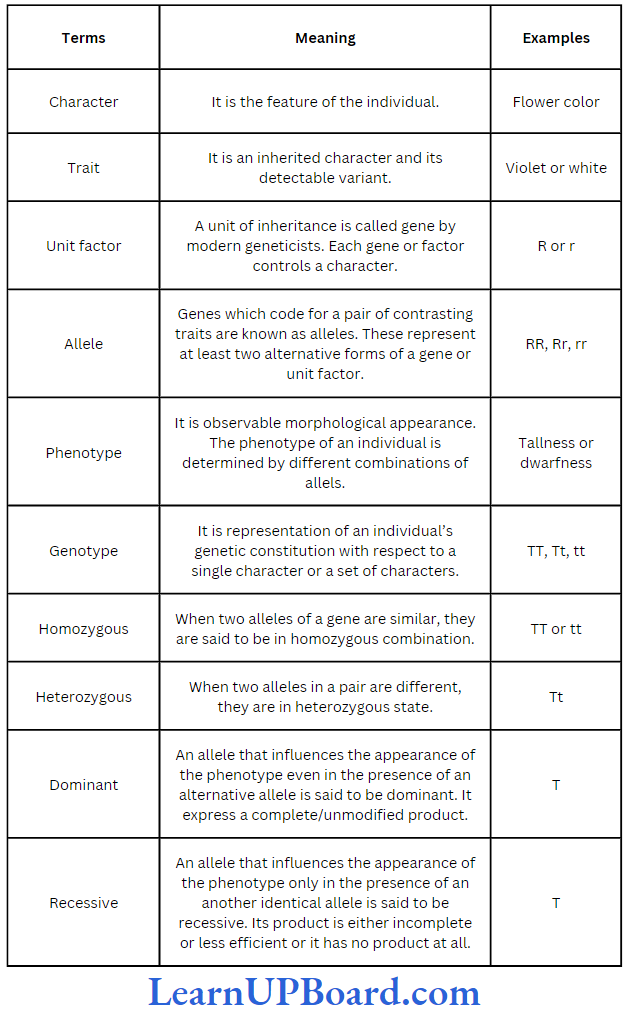
NEET Biology Notes For Principles Of Inheritance And Variation Mendelian Inheritance
- Mendel was born on July 22, 1822. He worked on Pisum sativum (garden pea or edible pea) for 7 years by taking 7 pairs of contrasting traits.
- The results were read out in two meetings of the Natu- ral History Society of Brunn in 1865.
- His paper “Experiments on Plant Hybridization” was published in the fourth volume of “Proceedings of Natural Science Society of Brunn” in 1866.
- Mendel was the first to apply statistical analysis and mathematical logic.
- He selected 14 true breeding pea plant varieties.
- He died due to kidney disorder in 1884.
- Mendel selected the characters listed in Table 5.1, in pea plant, for carrying out hybridization experiments.
- Mendel failed to produce the same results in hawk- weed (Hieracium) and beans (Lablab). Detailed inves- tigation by S. Blixt on pea plant led to locate Mendel’s seven characters on four different chromosomes-1, 4, 5, and 7.
- However, Mendel’s work did not receive any recognition, it deserved, till 1900.
- Mendel’s work remained unnoticed and unappreciated for several years due to the following reasons:
- Communication was not easy in those days and his work could not be widely publicized.
- His concept of stable, unblending, and discrete units or factors for various traits did not find acceptance from the contemporaries.
- His approach of using mathematical and statistical analysis to explain biological phenomena was totally new and unacceptable to many biologists of that time.
- He could not provide any physical proof for the existence of factors. It was the rediscovery of his work by Hugo de Vries (a Dutch), Carl Correns (a German), and Erich von Tschermak (an Austrian botanist), independently in 1900, that brought Mendel to limelight. Correns raised the status of Mendel’s generalizations to laws.
- Selection of pea plant: The main reasons for adopting garden pea (Pisum sativum) for experiments by Men- del were as follows:
- Pea has many distinct alternative traits (clear con- trasting characters).
- The lifespan of pea plant is short.
- Flowers show self (bud) pollination and, so, are true breeding.
- It is easy to artificially cross-pollinate the pea flowers. The hybrids, thus, produced were fertile.
principles of inheritance and variation class 12
Mendel’s Work and Results
- Mendel made cross between parents having contrasting traits.
- Firstly he made monohybrid cross (cross between parents that differ from each other in one character) followed by dihybrid cross (cross between parents that differ from each other in two characters) and finally trihybrid cross.
- The F, hybrids were self-crossed to give rise to F2 gen- eration.
- Mendel also carried out reciprocal crosses and found that these gave the same result. (Reciprocal cross means opposite cross, i.e., the parent that provides male gamete in one cross provides female gamete in the second experiment and vice versa).
- The result of reciprocal cross proves that both gametes produce the same effect and it does not matter which parent provides male and which one provides female gamete.
- On the basis of his experimental crosses, he formulated four postulates.
- Postulate 1: According to this postulate, characters are controlled by a pair of unit factors. The two factors are now called alleles or allelomorphic pair.
- Postulate 2: If two dissimilar unit factors are present in an individual, only one expresses itself. The one which expresses itself is known as the dominant fac- tor, while the second which does not express at all is known as the recessive factor.
- Postulate 3: According to this postulate, two contrasting alleles responsible for contrasting traits pre- sent in an individual do not get mixed and get separated from each other at the time of gamete formation by F1 hybrid. Due to their recombination, four combinations can be obtained in equal frequency.
- All three postulates are based on Mendel’s monohybrid cross or one-gene interaction.
- Law of dominance and law of segregation can be explained on the basis of monohybrid cross or one-gene interaction.
- Law of dominance:
- This law states that when two contrasting alleles for a character come together in an organism, only one is expressed completely and shows visible effect.
- This allele is called dominant and the other allele of the pair which does not express and remains hidden is called recessive.
- This law is not universally applicable. Plant height is controlled by two alleles dominant allele (T) and recessive allele (t). These two alleles can be present in three forms.
- Mendel crossed two pea plants-one homozygous tall (TT) and another homozygous dwarf (tt).
- He observed that all the F, progeny plants were tall; like one of the parents, none were dwarf.
- He made similar observations for the other pair of traits and found that F, always resembled only one of the parents, and that the traits of the other parent were not seen in them.
- Law of dominance:
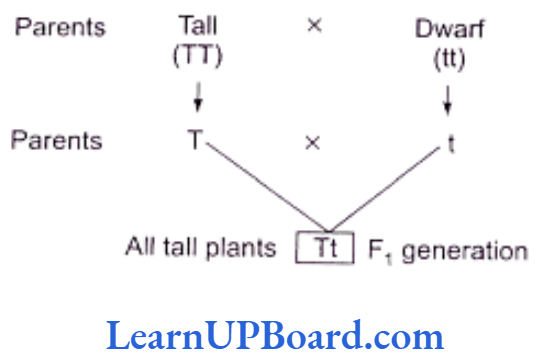
- Law of segregation or law of purity of gametes
- This law states that both parental alleles (recessive and dominant) of F, generation separate and are expressed phenotypically in F2 generation. This law is universally applicable.
- The F2 generation was produced by allowing the F, hybrid to self-pollinate, to find out segregation or separation.
- It was observed that both dominant and recessive plants appeared in the ratio of 3: 1. Thus, F2 progeny shows both parental forms.
- On the basis of F2 generation, following observations can be made.
- An organism generally has two alleles for each character. These alleles may either be similar or dissimilar. An organism with similar alleles of a pair is called pure or true breeding for that character. If the organism contains dissimilar alleles of a pair, the organism is impure or hybrid.
- An organism receives one of the two alleles from the male gamete and the other from the female gamete. The gametes fuse during fertilization and form a zygote. Zygote develops into an organism.
- Each gamete (male or female) has only one allele of the pair. Thus, each gamete is pure for a trait. That is why this law is often called the law of purity of gametes.
- Fusion between male and female gametes to produce a zygote is a random process.
- Plants obtained in F2 generation show 3 (tall): 1 (dwarf) phenotypic ratio. Of these three tall plants, one is pure or homozygous dominant and the remaining two are heterozygous (tall in this case). There is only one plant that shows recessive character (dwarf in this case). Dwarf is pure or true breeding, being homozygous recessive.
- Postulate 4
- This postulate was made on the basis of dihybrid cross or two-genes interaction.
- He postulated that the inheritance of one character is independent of the inheritance of another character.
- On the basis of this postulate, Mendel proposed the “law of independent assortment.”
- Law of independent assortment
- The law of independent assortment states that when a cross is made between two individuals different from each other in two or more characters, then the inheritance of one character is independent of the inheritance of another character.
- Because of their independent assortment, besides the parental types, recombinants are also obtained.
- In dihybrid cross, these combinations are obtained in the ratio of 9:3:3: 1. For example, Mendel crossed homozygous dominant round and yellow seeded plant (RRYY) with homozygous recessive wrinkled and green seeded (rryy) plant.
- The F, hybrids were all heterozygous, showing yellow and round seeded plants.
- This law is not universally applicable.
- Law of segregation or law of purity of gametes
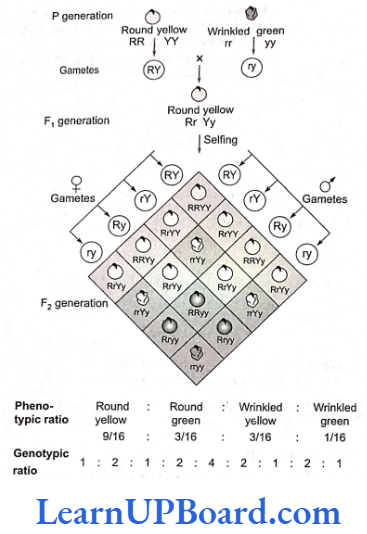
- If the phenotypic ratio of each pair of alleles (e.g., yellow and green color of seed) is considered, it shows 12 (=9+3) yellow seeded plants and 4 (= 3 + 1) green seeded plants.
- This comes to the ratio 3: 1, similar to the one obtained in the F2 generation of monohy- brid cross showing segregation.
- The same is true for another pair of alleles involved, i.e., round and wrinkled seeded plants. So, the results of each character are similar to the monohybrid ratio.
NEET Biology Notes For Principles Of Inheritance And Variation Summarized Account Of Mendel’s Experiments
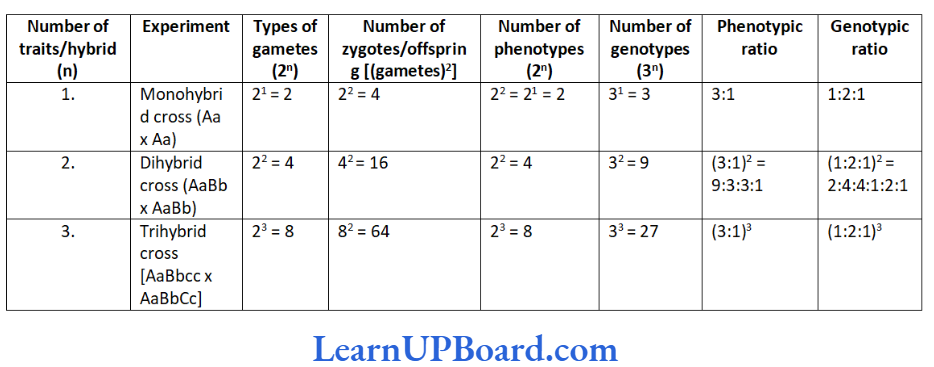
Back Cross and Test Cross
Back Cross
- F1 hybrids are obtained by crossing two plants of parental generation.
- Mendel devised a cross where the F, hybrid is crossed with any one of the two parents, i.e., homozygous dominant and homozygous recessive.
- Thus, there will be two possibilities:
- F1 hybrid (Tt) is crossed with homozygous dominant (TT).
- F1 hybrid (Tt) is crossed with homozygous recessive (tt).
- Both these crosses collectively are called back cross. If F, is crossed with dominant parent, it is called out cross.
Test Cross
- Out of the two types of back crosses, a cross between F, hybrid (Tt) and its homozygous recessive parent (tt) is called test cross.
- This cross is called test cross because it helps to find out whether the given dominant F, phenotype is homozygous or heterozygous.
- A monohybrid test cross between F, tall plant (Tt) and its homozygous recessive parent (tt) will produce 50% heterozygous tall (Tt) and 50% homozygous recessive (tt), i.e., ratio 1: 1, for both phenotype and genotype.
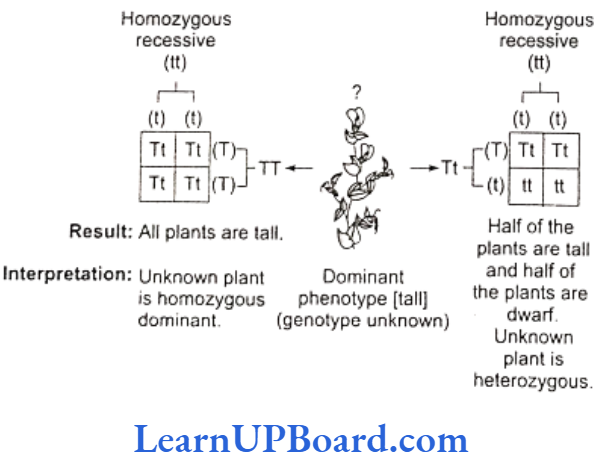
- If a test cross with two characters, i.e., dihybrid test cross, is made, it gives four types of plants in the ratio 1:1:1:1.
- The phenotypes obtained are similar to those found in the F2 generation of dihybrid cross.
- Thus, a dihybrid test cross between F, yellow and round seeded plant (YyRr) and its homozygous recessive green and wrinkled parent (yyrr) will give the following combinations:
- 1 yellow, round (YyRr); parental combination 25%
- 1 yellow, wrinkled (Yyrr); recombinants 25%
- 1 green, round (yyRr); recombirants 25%
- 1 green, wrinkled (yyrr); parental combination 25%
- If this ratio is obtained, it will be confirmed that F, hybrid with dominant phenotype is in fact heterozygous.
- The parental combinations (50%) are equal to the frequency of recombinants (50%).
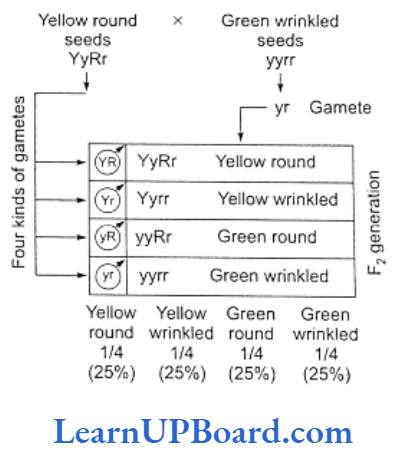
Trihybrid Cross
- Mendel crossed two pea plants, which differed in three characters, and observed independent assortment of genes in them.
- He crossed two pea plants pure in three traits viz., height of stem, form of seed, and color of cotyledon of seed.
- The plants crossed were homozygous tall, round, and yellow (TT RR YY) plant and dwarf, wrinkled, and green (tt rr yy) plant.
- All F, individuals produced were tall, round, and yellow (Tt Rr Yy). These are called trihybrids.
- On selfing trihybrids, F2 phenotypic ratio is 27:9:9 :9:3:3:3:1. The ratio for a trihybrid test cross is 1:1:1:1:1:1:1:1.
NEET Biology Notes For Principles Of Inheritance And Variation One-Gene Interaction (With Respect To Post-Mendelian Inheritance)
- Incomplete dominance
- After Mendelism, a few cases were observed where F, phenotype was intermediate between dominant and recessive phenotypes.
- The most common example of incomplete dominance is that of flower color in Mirabilis jalapa (Gulbansi or 4’0 clock plant), studied by Carl Correns.
- Homozygous red (RR) flowered variety was crossed with white (rr) flowered variety.
- F, offspring had pink flowers.
- Thus, here one allele is incompletely dominant over the other so that intermediate phenotype is produced by F, hybrid with respect to the parents.
- This is called incomplete dominance.
- Incomplete dominance for flower color [red (RR), pink (Rr), white (rr)] is also known to occur in Antirrhinum majus (snapdragon or dog flower).
- The phenotypic ratio and genotypic ratio in F2 generation are identical in case of incomplete dominance, i.e., 12:1
- Explanation of the concept of dominance
- Every gene contains information to express a particular trait.
- Diploid organisms have two copies of each gene. These are called alleles.
- These two alleles may be identical or non-identical.
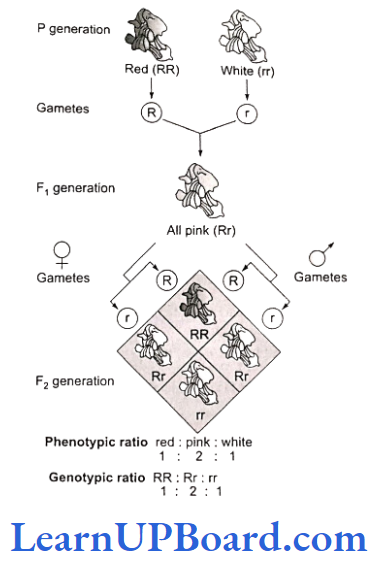
- One of them may be different due to some changes it has undergone which modifies the information that particular allele contains.
- Theoretically, the modified allele could be responsible for the production of
- normal/less efficient enzyme or
- a non-functional enzyme or
- no enzyme at all.
- In case (1), the modified allele is equivalent to the unmodified allele, i.e., it will produce the same phenotype/trait.
- But if the allele produces a non-functional enzyme or no enzyme [cases (2) and (3)], the phenotype may be affected.
- The unmodified (functioning) allele which represents the original phenotype is the dominant allele and the modified allele is generally the recessive allele.
- Hence, the recessive trait is due to nonfunctional enzyme or because no enzyme is produced.
- If the mutated allele forms an altered but functional product, it behaves as incomplete or co- dominant allele.
- Multiple allelism
- Mendel proposed that each gene has two contrasting forms, i.c., alleles.
- But there are some genes that have more than two alternative forms (alleles).
- The presence of more than two alleles for a gene is known as multiple allelism.
- Multiple alleles are present on the same locus of homologous chromosome.
- These alleles can be detected only in a population.
- A well known example to explain multiple alleles in human beings is ABO blood type.
- Landsteiner discovered ABO system of blood groups. The fourth group, AB, was discovered by de Castello and Steini.
- Bernstein showed that these groups are controlled by three alleles I^, 13, and 1°/i.
- These alleles are autosomal and follow the Mendelian pattern of inheritance.
- Alleles I^ and I produce a slightly different form of sugar while 1o does not produce any sugar. Because humans are diploid organisms, each person possesses any two of the three “I” gene alleles.
- IA and IB are completely dominant over 1°, but when I and I are present together, they both ex- press their own types of sugar, thus, behaving as codominant alleles.
“principles of inheritance “
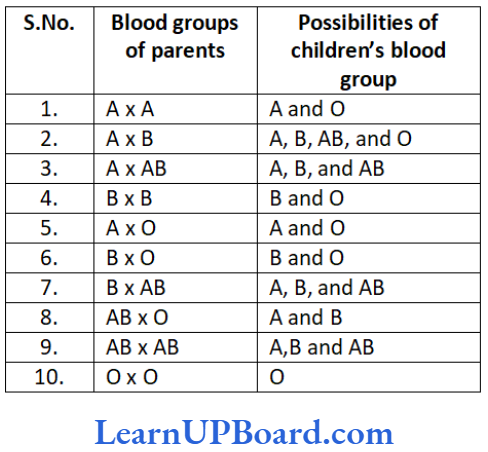
- Other examples of multiple alleles are coat color in rabbit, eye color in Drosophila, and self-incompatibility in tobacco. The formula to find the number of genotypes for multiple allelism is (n/2)(n+1), where n is the number of alleles.
- Co-dominance
- In co-dominance, the genes of an allelomorphic pair are not related as dominant and recessive- both of them express themselves equally in F, hybrids.
- These follow the law of segregation and F2 progeny exhibits ratio 1 2 1. Heterozygous for sickle-cell anaemia (Hb^Hb), AB, and MN blood groups are examples of co-dominance of alleles.
- Lethal genes or lethality
- A lethal gene usually results in the death of an individual when present in homozygous condition. The most striking example to explain lethal gene is sickle-cell anaemia (HbsHb).
- Cuenot (1905) first reported that inheritance in the mouse body color did not agree with Mendelian inheritance, because the dominant allele for yel- low body color is lethal in homozygous condition.
- The homozygous dominant gene carrying mouse died, proving that dominant gene is lethal in homozygous form.
- This is called absolute lethality. In plants, it was first reported in Antirrhinum majus by E. Baur, where yellow leaved or golden leaved or aurea plant never breeds true. Thus, the ratio comes out to be 2: 1.
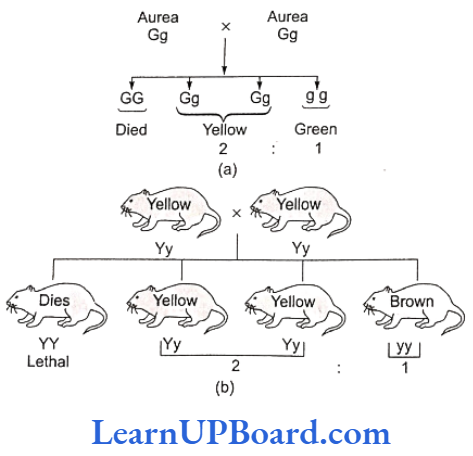
- Pleiotropic genes
- The ability of a gene to have multiple phenotypic effects (as it influences a number of characters simultaneously) is known as pleiotropy.
- The gene having multiple phenotypic effects is called pleiotropic gene.
- It is not essential that the traits are equally influenced. Sometimes, the effect of the gene is more evident in case of one trait (major effect) and less evident in case of others (secondary effect).
- Occasionally, a number of related changes are caused by a gene. These are together called syn- drome.
- Some common examples in humans are cystic fibrosis, Marfan syndrome, and phenylketonuria, while in Drosophila, a single gene influences the size of wings, the character of balancers, the po- sition of dorsal bristles, eye color, the shape of spermatheca, fertility, and longevity.
- In human beings, pleiotropy is exhibited by sickle-cell anaemia in heterozygous condition (Hb*Hbs).
- In case of pea, the gene which controls starch synthesis also controls the shape of the seed.
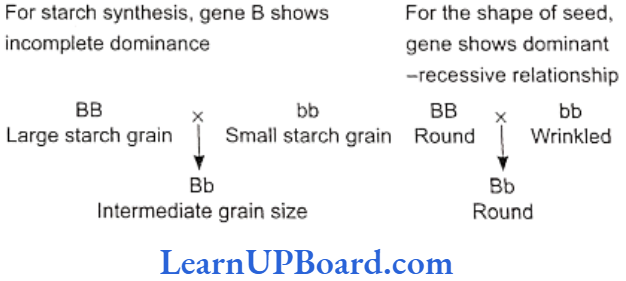
NEET Biology Notes For Principles Of Inheritance And Variation Two-Genes Interaction (With Respect To Post-Mendelism)
- Genes usually function or express themselves singly or individually.
- But many cases are known where two genes of the same allelic pair or genes of two or more different allelic pairs influence one another.
- This is called gene interaction.
Non-Allelic Genetic Interactions
- Non-allelic genetic interactions are interactions between genes located on the same chromosome or on different but non-homologous chromosomes controlling a single phenotype to produce a different expression.
- Each interaction is typical in itself and the ratios obtained are different from the Mendelian dihybrid ratios.
- Some of these interactions of genes, which fall under this category and deviate from Mendel’s ratios, are explained here.
- Complementary genes
- Complementary genes are two genes present on separate loci that interact together to produce a dominant phenotypic character; neither of them if present alone can express itself. It means that these genes are complementary to each other.
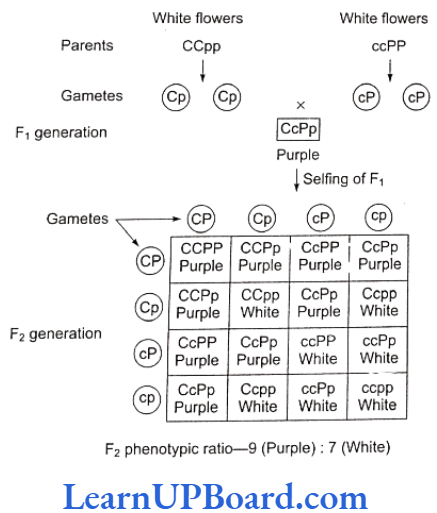
- Bateson and Punnet have demonstrated that in sweet pea (Lathyrus odoratus), the purple color of flowers develops as a result of interaction of two dominant genes, C and P.
- In the absence of dominant gene C or P or both, the flowers are white.
- It is believed that gene C produces an enzyme which catalyzes the formation of necessary raw material for the synthesis of pigment anthocyanin and gene P produces an enzyme which transforms the raw material into the pigment.
- It means the pigment anthocyanin is the product of two biochemical reactions; the end product of one reaction forms the substrate for the other.

- Therefore, if a plant has ccPP, ccPp, CCpp, or Ccpp genotype, it bears only white flowers. Purple flowers are formed in plants having genotype CCPP, CCPp, CCPP, or CcPp.
- From the checker board, it is clear that 9: 7 ratio between purple and white is a modification of 9:3:3:1 ratio.
- Duplicate genes
- If the dominant alleles of two gene loci pro- duce the same phenotype, whether inherited together or separately, the 9:3:3:1 ratio is modified to 15: 1.
- Example: The capsules of shepherd’s purse (Capsella) occur in two different shapestriangular and top-shaped. When a plant with triangular capsule is crossed with one having top-shaped capsule, in F1, only tri- angular character appears. The F, offspring by self-crossing produces F2 generation with triangular and top-shaped capsules in the ratio of 15: 1.
- Two independently segregating dominant genes (A and B) have been found to influence the shape of the capsule in the same way. All genotypes having dominant alleles of both or either of these genes (A and B) will produce plants with triangular capsules. Only those with genotype aabb will produce plants with top-shaped capsules.
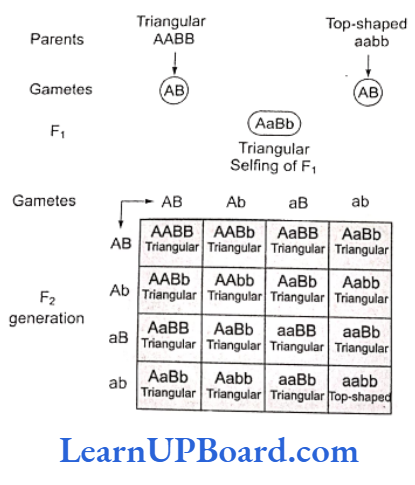
- Epistasis
- A gene which masks (hides) the action of an- other gene (non-allelic) is termed as epistatic gene. The process is called epistasis. A gene whose effects are masked is termed as hypostatic gene.
- Epistasis is of two types:
- Recessive epistasis
- Here the recessive allele in homozygous condition masks the effect of dominant allele. For example, in mice, the wild body color is known as agouti (grayish); it is controlled by a gene say A which is hypostatic to recessive allele c.
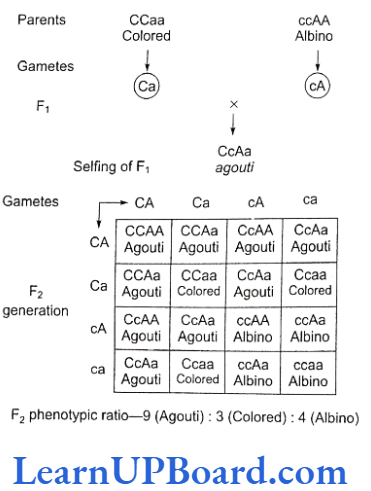
inheritance class 12
- Dominant allele C in the presence of a gives colored mice.
- In the presence of dominant allele C, A gives rise to agouti.
- So, CCaa will be colored and ccAA will be albino.
- When colored mice (CCaa) are crossed with albino (ccAA), agouti mice (CcAa) appear in F1.
- cc masks the effect of AA and is, therefore, epistatic.
- Consequently, ccAA is albino.
- The ratio 9:3:3: 1 is modified to 9:3:4.
- The combination ccaa is also albino due to the absence of both the dominant alleles.
- Dominant epistasis
- In summer squash, or Cucurbita pepo, there are three types of fruit colors-yellow, green, and white.
- White color is dominant over other colors, while yellow is dominant over green.
- The gene for white color (W) masks the effects of yellow color gene (Y).
- So, yellow color is formed only when the dominant epistatic gene is represented by its recessive allele (w). When the hypostatic gene is also recessive (y), the color of the fruit is green.
White fruit: W-Y-, W-y-
Yellow fruit: wwY-
Green fruit: wwyy
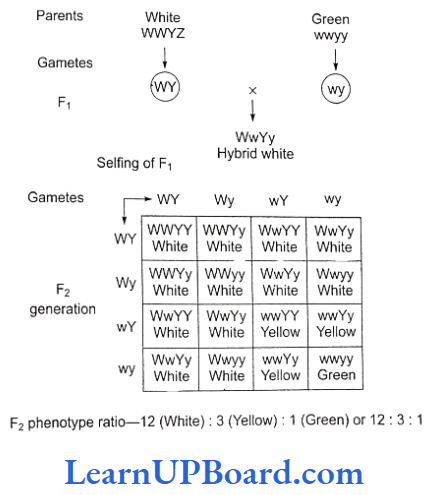
- A cross between a pure breeding white summer squash (WWYY) with a pure breeding green summer squash (wwyy) yields white fruits in the F, generation. Upon selling of F1, the F2 generation comes to have white, yellow, and green fruits, respectively, in the ratio of 12:3: 1.

Polygenic Inheritance or Quantitative Inheritance
- Quantitative inheritance is controlled by two or more genes in which the dominant alleles have cumulative effect, with each dominant allele expressing a part of functional polypeptide and full trait is shown when all dominant alleles are present.
- Genes involved in quantitative inheritance are called polygenes.
- Swedish geneticist, H. Nilsson-Ehle (1908), and East (1910) demonstrated the segregation and assortment of genes controlling quantitative traits. For example, kernel color in wheat and corolla length in tobacco.
- H. Nilsson-Ehle crossed red kerneled variety with white kerneled variety of wheat.
- The grains of F, were uniformly red but intermediate between the red and white of parental generation.
- When the members of F, were self-crossed among themselves, five different phenotypic classes appeared in F2 showing the ratio of 1:4: 6:4: 1.
- Extreme red-1/16 (as red as to the parent of F1)
- Deep red (dark red)-4/16
- Intermediate red-6/16 (similar to F1)
- Light red-4/16
- White-1/16 (as white as to the parent of F1)
- Nilsson-Ehle found that the kernel color in wheat is determined by two pairs of genes-AA and BB.
- Genes A and B determine the red color of kernel and are dominant over their recessive alleles. Each gene pair shows Mendelian segregation.
- Heterozygotes for two pairs of genes (AaBb) segregate into 15 red and 1 white kerneled plants.
- But all red kernels do not exhibit the same shade of redness.
- The degree of redness was found to correspond with the number of dominant alleles.
Skin Color in Man
- The presence of melanin pigment in the skin deter- mines the skin color.
- The amount of melanin developing in the individual is determined by three (two also) pairs of genes. These genes are present at three different loci and each dominant gene is responsible for the synthesis of fixed amount of melanin.
- The effect of all the genes is additive and the amount of melanin produced is always proportional to the number of dominant genes.
- Subsequent studies after Davenport have shown that as many as six genes may be involved in controlling the skin color in human beings.
- The effect of all genes is additive. (The character is assumed to be fixed by three pairs of polygenes.)
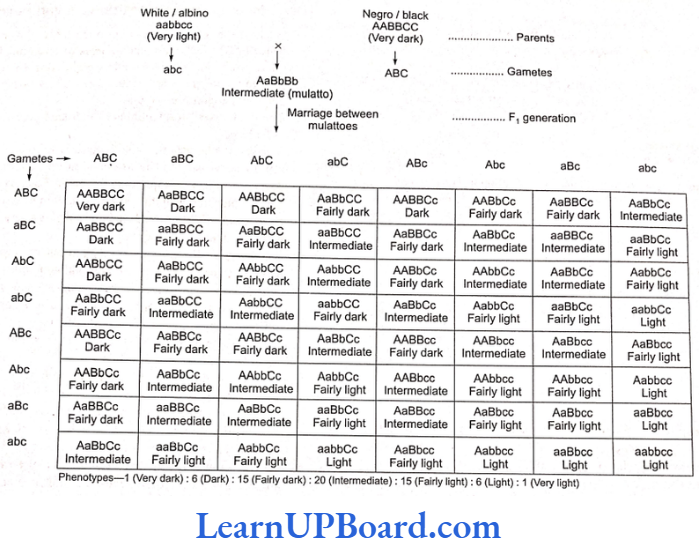
- The F1 progeny between an albino and a Negro individual, called mulatto, produces intermediate skin color.
- In F2 generation, the colored offsprings exhibit different shades in the ratio 1:6:15:20:15:6:1.
- The frequency distribution for skin color can be rep- resented either as a histogram or in the form of a bell- shaped normal distribution curve.
- Looking at the histogram, it can be concluded that in polygenic inheritance, the extreme phenotypes are rare and the intermediate ones are more frequent.
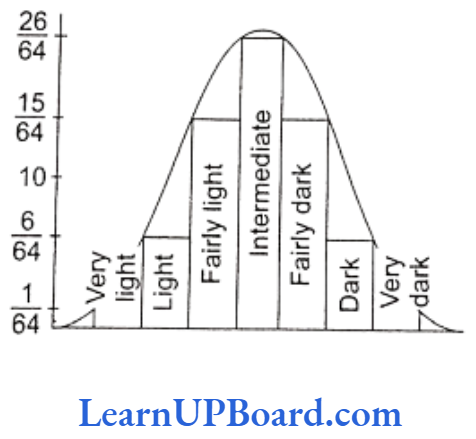
Some other examples of quantitative traits are cob length in maize; human intelligence; milk and meat production; height in humans; and size, shape, and number of seeds and fruits in plants.
- Number of phenotypes for polygenes = 2n + 1
- Number of genotypes for polygenes=3″, where n represents pairs of polygenes
NEET Biology Notes For Principles Of Inheritance And Variation Chromosomal Theory Of Inheritance/Parallelism Between Chromosomes And Mendelian Factors
- The chromosomal theory of inheritance was proposed independently by Sutton and Boveri.
- The two workers found a close similarity between the transmission of hereditary traits and the behavior of chromosomes while passing from one generation to the next through the agency of gametes.
- They noted that the behavior of chromosomes is parallel to the behavior of Mendelian factors (genes).
- The salient features of chromosomal theory of inheritance are as follows:
- Like hereditary traits, chromosomes retain their number, structure, and individuality throughout the life of an organism and from generation to generation. The two neither get lost nor mixed up. They behave as units.
- Both chromosomes as well as genes occur in pairs in the somatic or diploid cells. The two alleles of a gene pair are located on homologous sites on homologous chromosomes.
- A gamete contains only one chromosome of a type and only one of the two alleles of a trait.
- The paired condition of both chromosomes as well as Mendelian factors is restored during fertilization.
- Homologous chromosomes synapse during meiosis and then separate or segregate independently into different cells. This establishes the quantitative basis for segregation and independent assortment of hereditary factors.
- Sutton united the knowledge of chromosomal segregation with Mendelian principles and called it the chromosomal theory of inheritance.
- Johannsen (1909) coined the term gene for Mendelian factor.
- Following the synthesis of ideas, the experimental verification of the chromosomal theory of inheritance by T.H. Morgan and his colleagues led to the discovery of the basis for variations that sexual reproduction produced.
- Thomas Hunt Morgan (1866-1945) is known as the father of experimental genetics. He was awarded the No- bel Prize of physiology in 1933 for his pioneer work in experimental genetics.
Drosophila melanogaster as Material for Experimental Genetics
- Fruit fly Drosophila is a tiny fly of size about 2 mm. It is found over ripe fruits like mango and banana.
- The fly is actually attracted to the yeast cells present on the surface of ripe fruits. Drosophila is more suitable than pea as experimental material because of the following reasons:
- It can be easily reared and bred under laboratory conditions.
- The fly has a short life span of about 2 weeks. It can be bred throughout the year so that numerous generations can be obtained in a single year instead of one as in case of pea.
- A single mating produces hundreds of offsprings. Females are easily distinguishable from males by the larger body size and the presence of ovipositor (egg laying structure).
- It shows a number of externally visible and easily identifiable contrasting traits.
- It has a smaller number (four pairs) of morpho- logically distinct chromosomes.
- Polytene chromosomes occur in the salivary glands of larva. These can be used to study different types of chromosome aberrations.
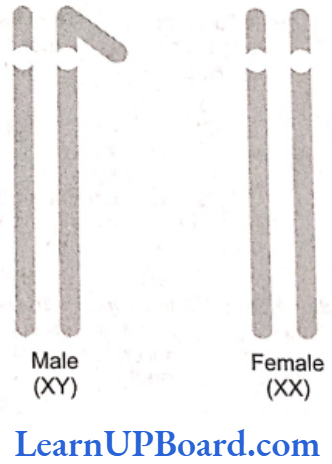
- The fly has heteromorphic (XY) sex chromosomes in the male. The transmission of heteromorphic chromosomes can be easily studied from one generation to another.
NEET Biology Notes For Principles Of Inheritance And Variation Linkage (Exception To Law Of Independent Assortment)
- According to Mendel’s law of independent assortment, genes controlling different characters get assorted in- dependent to each other.
- This is correct if the genes are present on two different chromosomes. But if these genes are present on the same chromosome, they may or may not show independent assortment.
- If crossing-over takes place between these two genes, then the genes get segregated and will assort independent to each other. But if there is no crossing-over between these two genes, there is no segregation and, hence, only parental combination will be found in gametes.
- The tendency of some genes to inherit together (en bloc) is known as linkage.
- In 1906, Bateson and Punnet crossed two varieties of Lathyrus odoratus (sweet pea) and observed that the results do not agree with Mendel’s law of independent assortment.
- They formulated the hypothesis of coupling and re- pulsion to explain the unexpected F2 results of dihybrid cross between a homozygous sweet pea having dominant alleles for blue flowers (BB) and long pollen grains (LL) with another homozygous double recessive plant having red flowers and round pollen grains (bbll).
- Test cross ratio of 7:1:1:7 indicated that there was a tendency of the dominant alleles to remain together. Similar was the case with recessive alleles.
- It was called gametic coupling by Bateson and Punnet.
- Two dominant genes from one parent entered the same zygote more frequently than expected.
- The tendency of two dominant genes to remain together in the process of inheritance was called coupling.
- In another cross, they took a sweet pea plant with blue flowers and round pollens (BBII) and other plant with red flowers and long pollens (bbLL) and obtained the ratio of 177 1 by test crossing the F1 generation.
“principles of genetics pdf “
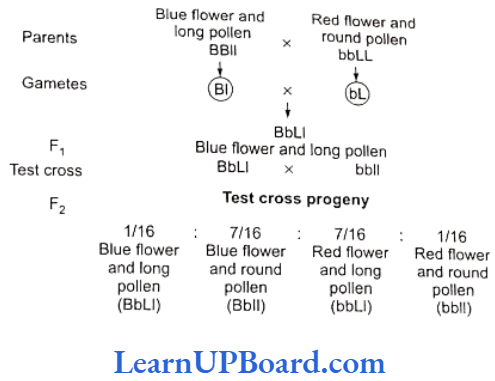
- When two dominant or recessive genes come from different parents, they tend to remain separate. Hence, this ratio was called repulsion ratio.
- T.H. Morgan in 1910 showed that coupling and repulsion are two aspects of the same phenomenon called linkage.
- He suggested that two genes when present on the same chromosome are in coupling phase and when present on two different homologous chromosomes are in re- pulsion phase.
- Morgan carried out several dihybrid crosses in Drosophila to study genes that were sex-linked.
- At first, he crossed yellow-bodied (y) white-eyed (w) female with brown-bodied (y) red-eyed (w*) male which produced F, with brown-bodied red- eyed female and yellow-bodied white-eyed male. In the F2 generation, obtained by intercrossing of F1 hybrids, the ratio deviated significantly from expected. He found 98.7% to be parental and 1.3% as recombinants.
- In a second cross between white-eyed miniature- winged female (wwmm) with wild-red-eyed (w’) normal-winged male (m), the F, generation included red-eyed normal-winged female and white-eyed miniature-winged male. After inter- crossing the F, progeny, he found 62.8% parental and 37.2% recombinants.
- On the basis of results, we can say that the strength of linkage between y and w is higher than that between w and m.
- According to Morgan, the degree or strength of linkage depends upon the distance between the linked genes in the chromosome..
- Linkage, therefore, may be defined as the tendency of two genes of the same chromosome to remain together in the process of inheritance.
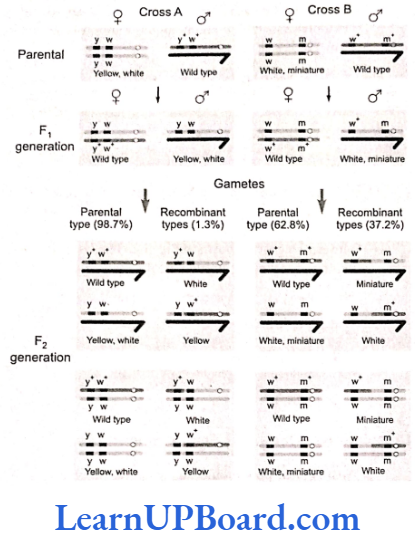
Kinds of Linkage
- T.H. Morgan and his coworkers found two types of linkage:
- Complete linkage
- It is the linkage of genes on a chromosome which is not altered and is inherited as such from generation to generation without any cross-over.
- In this type of linkage, the genes are closely associated and tend to remain together. Example: Male Drosophila and female silk- worm (Bombax mort).
- Complete linkage
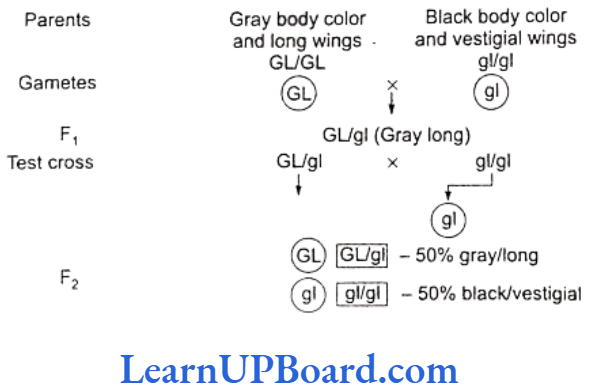
- 100% parental combinations indicated that the gene for gray body color is completely linked with long wings.
- In this dihybrid, F2 phenotypic ratio is 3:1 and test cross ratio is 1:1 (like a monohybrid). Another example is the inheritance of red eye and normal wing (PV/PV) with purple eye and vestigial wing character (pv/pv).
- Incomplete linkage
- The linked genes do not always stay together because homologous non-sister chromatids may exchange segments of varying length with one another during meiosis.
- This is known as crossing-over.
- The linked genes that have chances of separation by crossing-over are called incompletely linked genes and the phenomenon of their in- heritance is called incomplete linkage.
- It produces both parental and recombinant types in variable ratio.
- Bateson and Punnet studied Lathyrus odoratus and defined coupling and repulsion of dominant and recessive genes.
- In the cis arrangement or coupling condition, the incomplete linkage ratio was 7:1:1:7 (14 parental, 2 recombinants).
- In the trans arrangement or repulsion case, the ratio was 1:7:7:1 (parental 14, recombinants 2).
- Example: In maize, incomplete linkage was observed by Hutchinson with respect to seed coat color and seed shape. The results showed that parental combinations of alleles (CS/CS and cs/cs) appeared in about 96% cases. The other two were new combinations (Cs/cs and cS/cs) that appeared in about 4% cases. Thus, in about 4% cases, crossing- over occurred between linked genes.
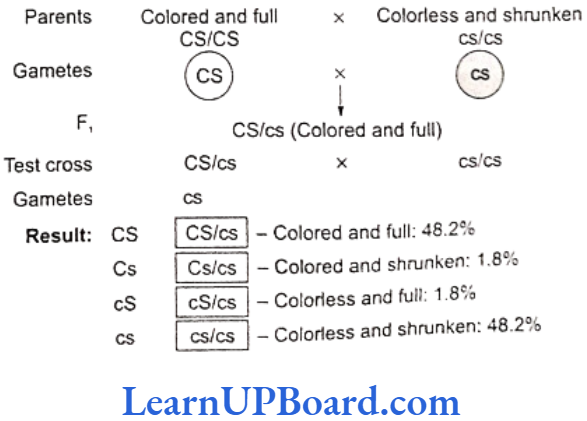
NEET Biology Notes For Principles Of Inheritance And Variation Crossing-Over And Recombination
- Crossing-over is a process that produces new combination of genes by interchanging segments between non-sister chromatids of homologous chromosomes.
- Crossing-over occurs between the homologous chromosomes at four-stranded or tetrad stage during pachytene of prophase 1 of meiosis 1.
- The condition where an individual heterozygous for two pairs of linked genes (AaBb) possesses two dominant genes on one member of the chromosome pair and two recessive genes on the other pair is said to be cis arrangement .
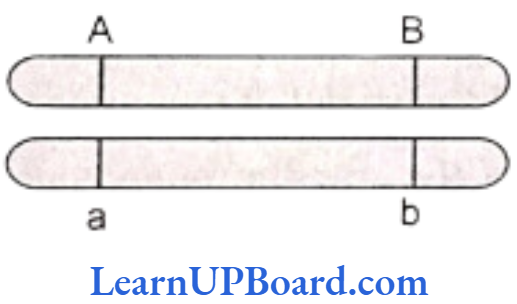
- If an individual heterozygous for two pairs of linked genes (AaBb) possesses one dominant and one recessive allele of each pair of genes on each member of the homologous pair of chromosomes, the arrangement is said to be trans arrangement.
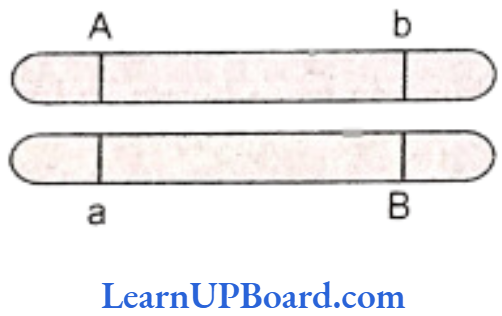
- When two genes are located very close to each other in chromosomes, hardly any crossing-over can be detected.
- The linkage is broken down due to crossing-over.
- Crossing-over will be relatively more frequent if the distance between two genes is more.
- The frequency of crossing-over can be determined cytologically by counting the number of chiasmata.
- The details of crossing-over for two genes A and B and their alleles a and b on homologous chromosomes.

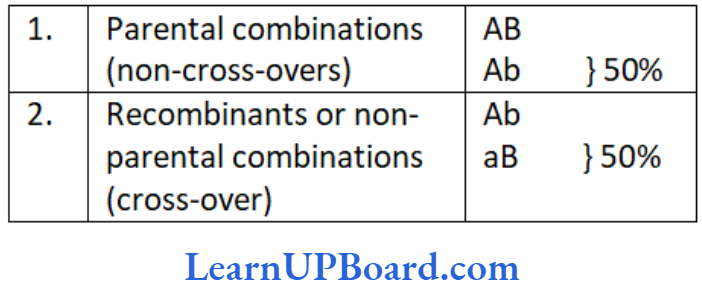
Crossing-Over Occurs at Four-Stranded Stage
- Neurospora (pink mould), an ascomycetous fungus, is used to demonstrate that crossing-over takes place at four-stranded stage.
- It has the following advantages as experimental organism:
- It is haploid and there is only one allele at each locus. Hence, dominant-recessive relationship does not interfere with observations and analysis.
- The products of single meiosis can be easily analyzed.
- The products of meiosis occur in the form of “ordered tetrads,” i.e., the eight ascospores formed are linearly arranged in a sac-like structure called ascus.
- If genes A and B are located on the same chromosome and undergo independent assortment, the genotype of linearly arranged ascospores can be studied.
- If crossing-over takes place at two-strand stage, the ascospores would show Ab, Ab, Ab, Ab, aB, aB, aB, aB (i.e., 4 Ab+4 aB) arrangement [Fig. 5.24(a)]. If crossing-over takes place at four-strand stage, the ascospores would show AB, AB, Ab, Ab, aB aB, ab, ab (i.e., 2AB+2 Ab+2 aB + 2 ab) or 2: 4: 2 arrange- ment.
- Tetrad analysis has demonstrated the presence of such an arrangement and, thus, it is now confirmed that crossing-over occurs at four-stranded stage.
Factors Affecting Crossing-Over
- The distance between the genes is directly proportional to crossing-over.
- Cross-over decreases with age.
- X rays and temperature increase crossing-over.
- Centromere and heterochromatin positions decrease crossing-over.
- One cross-over reduces the frequency of other cross- over in its vicinity. This is called interference.
Chromosomal Mapping
- Crossing-over is important in locating the genes on a chromosome.
- The genes are arranged linearly on the chromosome.
- This sequence and the relative distances between various genes are graphically represented in terms of recombination frequencies or cross-over values (COV).
- This is known as the linkage map of chromosome.
- Distance or cross-over units are called centiMorgan (cM) or map unit.
- The term centiMorgan is used in eukaryotic genetics while the term map unit is used in prokaryotic genetics. Recombination frequency or

- Recombination frequency depends on the distance be- tween the genes.
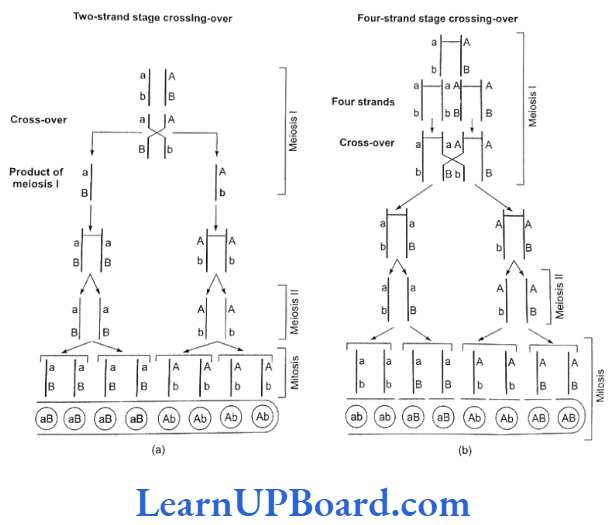
- If the distance between the genes is less, the chances of crossing-over are less and, hence, recombination frequency is also less, and vice versa. So, recombina- tion frequency is directly proportional to the distance between the genes.
- In any cross, if recombination frequency is 5%, it means the distance between the genes is 5 map units. A.H. Sturtevant suggested that these recombination frequencies can be utilized in predicting the sequence of genes on the chromosome.
- On the basis of recombination frequency, he prepared the first chromosomal map or genetic map for Drosophila.
NEET Biology Notes For Principles Of Inheritance And Variation Sex Determination
Sex Chromosomes and Autosomes
- Sex chromosomes are those chromosomes which determine the sex of the individual in dioecious or unisexual organisms.
- The normal chromosomes, other than sex chromosomes, of an individual are known as autosomes.
- Sex chromosomes may be similar in one sex and dissimilar in the other.
- The two conditions are, respectively, called homomorphic (similar, e.g., XX and ZZ) and heteromorphic (dissimilar, e.g., XY and ZW).
- Individuals having homomorphic sex chromosomes produce only one type of gametes.
- These are, therefore, called homogametic. For exam- ple, male birds, human female, and Drosophila female.
- Individuals having heteromorphic sex chromosomes produce two types of gametes.
- These are termed as heterogametic. For example, female birds, human male, and normal Drosophila male.
- The factors that control the sex of an organism are under genetic control.
- Various mechanisms that lead to sex determination can be classified into the following four categories:
- Chromosomal mechanism of sex determination
- Non-allelic genetic sex determination-fertility factor (plasmid) in bacteria
- Genic balance mechanism or X/A balance
- Environmental mechanism of sex determination
Chromosomal Mechanism of Sex Determination
- According to this mechanism, there are certain chromosomes known as sex chromosomes, or heterosomes or idiochromosomes, which are responsible for sex de- termination.
- This mechanism may be of the following types:
- XX-XY type
- In most insects, plants, and mammals including human beings, females possess two homomorphic (isomorphic) sex chromosomes, i.c., XX.
- Males possess two heteromorphic sex chromosomes, i.e., XY. The Y-chromosome is often shorter and heterochromatic (made of heterochromatin).
- Despite the differences in morphology, the Y- chromosome pairs with the X-chromosome at a certain segment during meiosis.
- It, therefore, carries a segment which is homologous with a segment of X-chromosome.
- The remaining segment of Y-chromosome is non-homologous and carries only Y-linked or holandric genes, e.g., testis-determining factor (TDF).
- XX-XY type
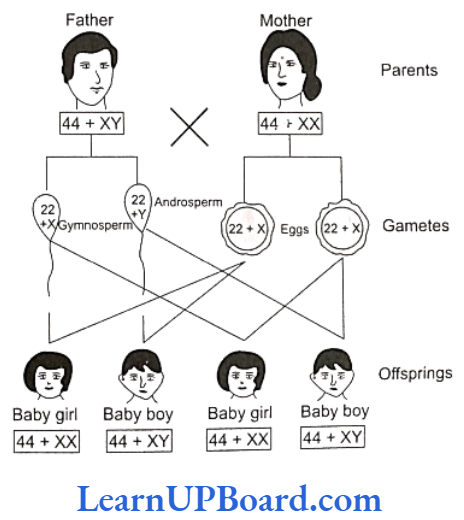
- Human beings have 22 pairs of autosomes and one pair of sex chromosomes.
- All the ova (haploid) formed by a female are similar in their chromosome type (22 + X). Therefore, females are homogametic.
- The male gametes or sperms (haploid) produced by human males are of two types-(22 + X) and (22 + Y).
- Human males are, therefore, heterogametic.
- The two sexes produced in the progeny may have 50: 50 ratio.
- This type of sex-determination was reported in plant Sphaerocarpus for the first time and is also found in plants such as Melandrium and Coccinia.
- XX-XO type
- In roundworms, Dioscorea, and some insects (true bugs, grasshoppers, and cockroaches), females have two sex chromosomes, XX, while males have only one sex chromosome, X.
- There is no second sex chromosome.
- Therefore, males are designated as XO.
- Females are homogametic because they pro- duce only one type of eggs.
- Males are heterogametic with half the male gametes carrying X-chromosome while the other half being devoid of it.
- The sex ratio produced in the progeny is 1:1.
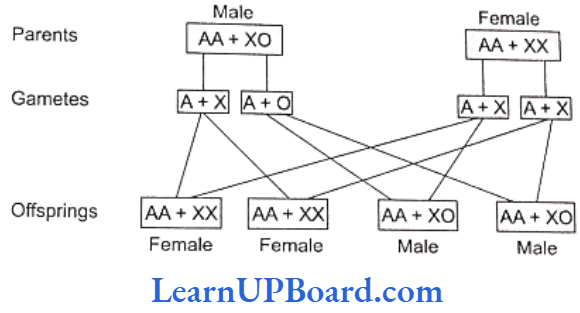
- ZW-ZZ type (WZ-WW type)
- In birds, fishes, silkworm, Fragaria elatior, and some reptiles, both sexes possess two sex chromosomes.
- Unlike human beings, females contain het- eromorphic sex chromosomes while males have homomorphic sex chromosomes.
- Because of having heteromorphic sex chromosomes, females are heterogametic and produce two types of eggs (A + Z) and (A + W).
- The male gametes or sperms are of one type (A + Z). The sex ratio produced in the offspring is 1 : 1.
- ZW-ZZ type (WZ-WW type)
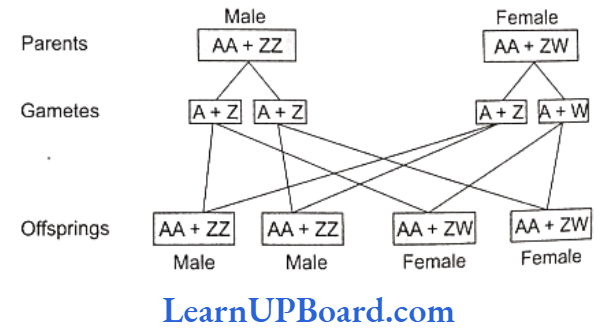
- ZO-ZZ type
- This type of sex determination occurs in butterflies, pigeon, ducks, and moths.
- It is exactly opposite of the condition found in cockroaches and grasshoppers.
- Here, females have odd sex chromosomes while males have two homomorphic sex chromosomes.
- Females are heterogametic.
- ZO-ZZ type
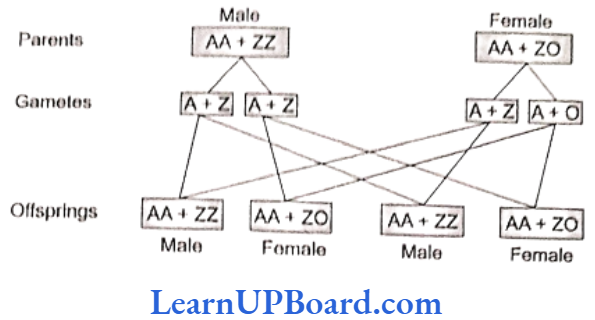
- They produce two types of eggs-with one sex chromosome (A + Z) and without the sex chromosome (A+0).
- Males are homogametic, forming similar types of sperms (A + Z).
- The two sexes are obtained in the progeny in the ratio of 1: 1 as both types of eggs are produced in equal ratio.
Arrhenotoky/Haploid-Diploid Mechanism
- This mechanism is found in honey bee. In honey bees, ants, and wasps, the egg, if fertilized, gives rise to female fly.
- The unfertilized egg develops parthenogenetically into male. So, female flies are diploid while male flies are haploid.
Non-Allosomic Genetic Sex Determination
The fertility factor of plasmid in bacteria determines sex.
Genic Balance or X/A Balance Theory of Sex Determination
- The genic balance theory of sex determination was given by C.B. Bridges. According to him, Y-chromosome plays no role in the sex determination of Drosophila; it is the ratio of the number of X-chromosomes to the set of autosomes which determines the sex of fly.
- It was concluded that the X/A ratio greater than 1 expresses superfemaleness, equal to 1 expresses femaleness, below 1 and above 0.5 expresses intersexes, equal to 0.5 expresses maleness, and less than 0.5 ex- presses supermaleness.

- Gynandromorphs: It is a sex mosaic (an individual with one-half of the body male and the other half female).
- Gynandromorphism is common in silk moth and Drosophila. It is developed due to the accidental loss of X-chromosome from a 2A+XX cell during mitosis.
- Gynander: A gynander may be male or female with patches of tissues of other sex on it.
Environmental Mechanism of Sex Determination
- The environmental mechanism of sex determination was observed by F. Baltzer in Bonnelia viridis (marine worm).
- In this organism, the sex is undifferentiated in larva.
- The larva that settle down in mud grow up into mature females, while those that settle down near the proboscis of a female and become parasites develop into males.
- It has been demonstrated that females secrete a certain hormone which induces sex in larva.
- Crepidula and Ophryortocha also show such mechanism.
NEET Biology Notes For Principles Of Inheritance And Variation Sex-Linked Inheritance
- Sex linkage was discovered by Morgan while working on the inheritance of eye color in Drosophila. He made three types of crosses:
- Cross 1
- White-eyed male (W) was crossed with red- eyed (W) female.
- All flies of the F, generation were found to be red eyed.
- F, flies were allowed to self breed.
- In the F2 generation, both traits, red eye and white eye, appeared in the ratio of 3: 1 showing that white eye trait is recessive to red eye trait.
- F1 generation consisted of only red-eyed flies. In F2 generation, all female flies were red eyed, 50% of the male flies were red eyed, and the remaining 50% were white eyed.
- Cross 1

- Cross 2
- Red-eyed females of F, generation were crossed with white-eyed male.
- It is similar to the test cross where hybrids are cross-bred with recessive parents.
- Morgan obtained red- and white-eyed females as well as males in equal proportions-1 red- eyed female 1 white-eyed female: 1 red- eyed male: 1 white-eyed male.
- The test cross indicated that white eye color was not restricted to the male fly.
- Cross 2

- Cross 3
- White-eyed females were crossed with red-eyed males. It was the reciprocal of cross 1 and should have given the same result as obtained by Mendel. However, Morgan obtained a surprising result. All males were white eyed while all females were red eyed.
- Cross 3
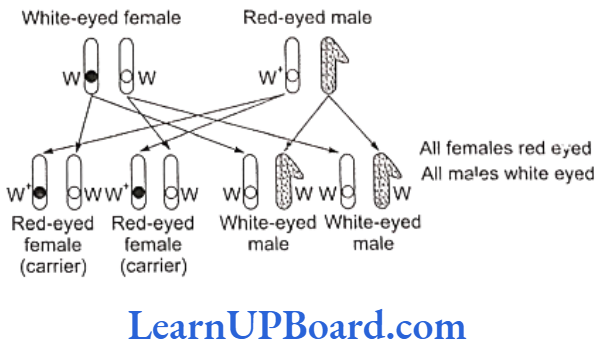
- Taking all crosses into consideration, Morgan came to the conclusion that eye color gene is linked to sex and is present on the X-chromosome.
- The X-chromosome does not pass directly from one parent to the offspring of the same sex but follows a criss-cross inheritance, i.e., it is transferred from one sex to the offspring of the opposite sex.
- In other words, in criss-cross inheritance, a male transmits his traits to his grandson through his daughter (diagynic), while a female transmits the traits to her granddaughter through her son (diandric).
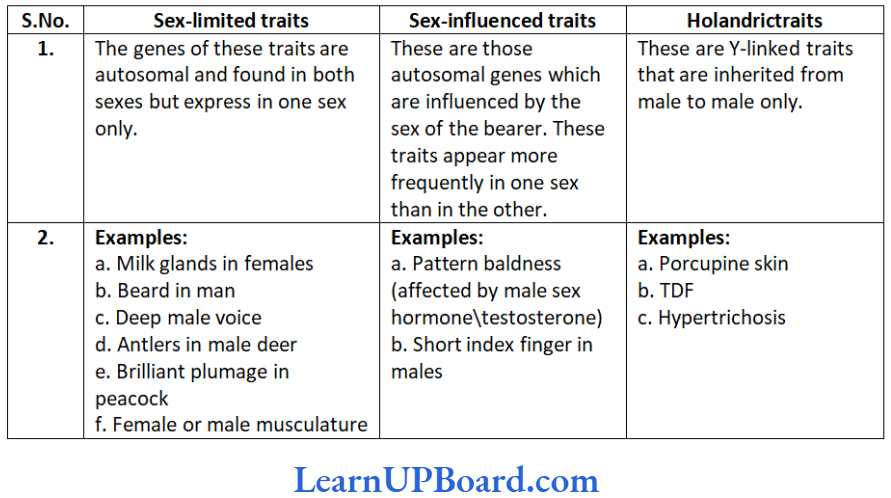
Sex Linkage in Human Beings
Colorblindness and hemophilia (Bleeder’s disease) are two common examples of sex-linked diseases in human beings.
- Colorblindness
- This is a human disease which causes the loss of ability to differentiate between red color and green color.
- The gene for this red-green colorblindness is present on the X-chromosome. Colorblindness is recessive to normal vision.
- If a colorblind man (XCY) marries a girl with nor- mal vision (XX), the daughters will have normal vision but will be carriers, while sons will also be normal.
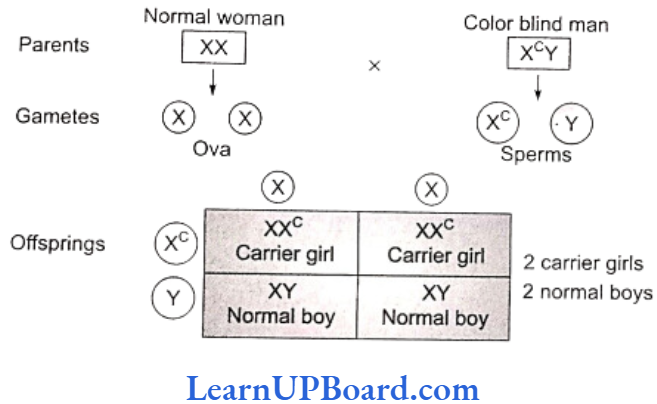
- If a carrier girl (heterozygous for colorblind- ness, XCX) now marries a colorblind man (XY), the offsprings will be 50% females and 50% males.
- Of the females, 50% will be carriers for color-blindness and the rest 50% will be colorblind.
- Of the males, 50% will have normal vision and 50% will be colorblind.
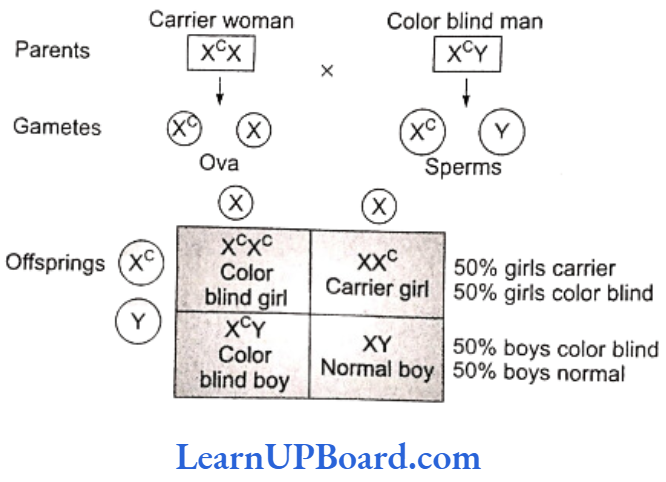
- Hemophilia (Bleeder’s disease)
- A person suffering from this disease cannot synthesize a normal blood protein called antihemophilic globulin (AHG) required for normal blood clotting. Hemophilia-A is more severe.
- Therefore, even a very small cut may lead to con- tinuous bleeding for a long time.
- This gene is located on the X-chromosome and is recessive.
- It remains latent in carrier females.
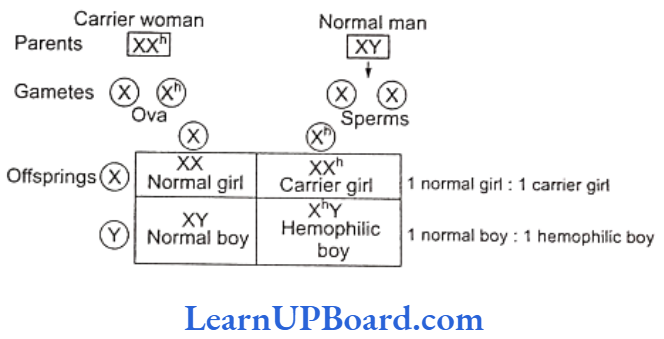
- If a normal man marries a girl who is a carrier of hemophilia, the progeny will consist of 50% females and 50% males.
- Of the females, 50% will be normal and the rest 50% will be hemophilia carriers.
- Of the males, 50% will be normal and the rest will be hemophiliacs.
- Hemophilia-B (Christmas disease): In this, plasma thromboplastin is absent. Inheritance is just like hemophilia-A.
NEET Biology Notes For Principles Of Inheritance And Variation Mutation
- Mutation is sudden, inheritable, discontinuous variation due to change in chromosomes and genes.
- Hugo de Vries (1901), one of the discoverers of Mendel’s laws, observed two distinct varieties of Oenothera lamarckiana (evening primrose).
- These differed in the length of stem, flower form, and the color and shape of leaves.
- These mutant varieties are now known to have been produced due to chromosomal aberrations.
- Seth Wright (1791) is considered to be the first to re- cord point or gene mutation.
- He noticed a lamb with unusually short legs.
- This short-legged breed of sheep was known as ancon breed.
- Darwin called this variation as sports.
- Bateson (1894) termed them as discontinuous or saltatory variations.
- The credit for starting the scientific study of mutations goes to Thomas Hunt Morgan (1910).
- He is known for his work on fruit fly, Drosophila melanogaster.
- He found white-eyed mutant of Drosophila. Since then, about 500 mutations have been observed by geneticists around the world.
Types of Mutations
Different classifications of mutations are known, each based on a definite criterion or character.
- On the basis of the agency involved
- Spontaneous mutations: Such mutations occur at a frequency of 1 x 105 in nature. These are natural mutations and have also been called back- ground mutations.
- Induced mutations: These have been observed in organisms due to specific factors such as radiations, ultraviolet light, or a variety of chemicals. The agents that induce mutations are called mutagens or mutagenic agents.
- On the basis of the type of cells in which mutations occur
- Somatic mutations: These mutations occur in the somatic cells, i.e., body cells or the cells other than germinal cells. These mutations do not have any genetic or evolutionary importance. This is because only the derivatives or the daughter cells formed from the mutated cell will show mutation and not the whole organism.
- Germinal mutations: These mutations occur in the gametes or germ cells and are also known as gametic mutations. Such mutations are heritable and, therefore, are of great evolutionary significance. If the mutations are dominant, these are expressed in the next generation, and if they are recessive, their phenotypic expressions remain suppressed.
- Forward and backward mutations
- The most common type of mutation is the change from the normal or wild type to a new genotype (recessive or dominant).
- Such mutations are called forward mutations.
- An organism which has undergone forward mutation may again develop mutation which restores the original wild-type phenotype.
- Such reversions are known as backward mutations or reverse mutations.
- Mutations can occur at any stage during the life cycle of an organism.
Some Other Types of Mutations
- Gene mutation
- It is alteration in the sequence of nucleotides in nucleic acids or any change in the sequence of triplet bases.
- If gene mutation arises due to change in single base pair of DNA, it is called point mutation.
- Gene mutation occurs by the following methods:
- Frame-shift mutation (gibberish mutation)
- Deletion: Removal of one or more bases from a nucleotide chain.
- Insertion or addition: Addition of one or more bases to a nucleotide chain.
- Substitution: The replacement of one base by another. It is of two types:
- Transition: When a purine base (A or G) is substituted by another purine base or a pyrimidine base (T or C) is substituted by another pyrimidine base.
- Transversion: The substitution of a purine base with a pyrimidine base or vice versa.
- Tautomerization: The purines and pyrimidines in DNA and RNA may exist in several alternate forms or tautomers. Tautomerization occurs through the rearrangement of electrons and protons in a molecule. Tautomers show changed base pairing so as to cause change in sequence, e.g., AT to CG.
- Nonsense mutation: Such mutation arises when a normal codon-coding for an amino acid-is changed into a chain- terminating codon (UAG, UAA, UGA) resulting in the production of an incomplete polypeptide.
Nonsense mutations rarely go unnoticed because the incomplete or shorter protein formed is generally inactive. - Mis-sense mutation: It involves change in base in a codon, producing a different amino acid at the specific site in a polypeptide. In mis-sense mutation, the change in one amino acid is frequently compatible with some biological activity, e.g., sickle-cell anemia.
- Nonsense mutation: Such mutation arises when a normal codon-coding for an amino acid-is changed into a chain- terminating codon (UAG, UAA, UGA) resulting in the production of an incomplete polypeptide.
- Frame-shift mutation (gibberish mutation)
- Chromosomal mutation (chromosomal aberrations)
- A change in chromosome morphology is called chromosomal aberration. Structural changes in chromosomes take place during meiosis. There are four types of chromosomal rearrangements:
- Deficiency or deletion
Deficiency occurs due to the loss of a terminal segment of chromosome. Deletion occurs due to the loss of an intercalary part of chromosome, e.g., cri-du-chat syndrome (short arm of chromosome 5 loses a part). - Duplication
It occurs due to the addition of a part of chromosome so that a gene or a set of genes is represented twice, e.g., Barr eye in Drosophila. - Translocation
It involves the shifting of a part of one chromosome to another non-homologous chromosome. So, new recombinant chromosomes are formed, as this induces faulty pairing of chromosomes during meiosis. An important class of translocation having evolutionary significance is known as reciprocal trans- location or segmental interchanges, which involves the mutual exchange of chromo some segments between non-homologous chromosomes, i.e., illegitimate crossing- over. Chronic myelogenous leukemia (CML) occurs due to the translocation of segment of long arm from chromosome 22 to chromosome 9. Chromosome 22 is called Philadelphia chromosome. - Inversion
Inversion is change in the linear order of genes by the rotation of a section of chromosome by 180°. It occurs frequently in Drosophila as a result of X-ray irradiation. It may be of two types:- Paracentric: It is inversion without involving centromere. (Inverted segment does not carry centromere.)
- Pericentric: It is inversion involving centromere.
- Deficiency or deletion
- A change in chromosome morphology is called chromosomal aberration. Structural changes in chromosomes take place during meiosis. There are four types of chromosomal rearrangements:
- Genomatic mutation or numerical changes in chromosome number: It is of two types:
- Aneuploidy: In aneuploidy, any change in the number of chromosomes in an organism will be different than the multiple of basic set of chromosomes. It results due to the failure of segregation of chromatids during cell division cycle. There will be following two possibilities:
- Hypoploidy: This arises due to the loss of one or more chromosomes or pairs of chro- mosomes. Thus, the following conditions are likely to be produced:
- Monosomy (2n-1): It is the result of loss of one chromosome for a homologous pair. Its other variant is double monosomy, i.e., (2n-1-1).
- Nullisomy (2-2): It is the result of loss of a complete homologous pair of chromosomes.
- Hyperploidy: This arises due to the addition of one or more chromosomes or pairs of chromosomes. The following conditions are, thus, likely to be produced:
- Trisomy (2n+1): In this type, a single chromosome is added to the chromo- some set. Trisomics were obtained for the first time in Datura stramonium (Jimson weed) by A.F. Blakeslee and his cowork- ers (1924). In human beings, Mongolism or Down’s syndrome is due to the trisomy of chromosome 21 (2n+1 or 46 + 1), i.e., chromosome 21 is present three times. Others are the Patau syndrome, due to the trisomy of the 13th, and Edward’s syndrome, due to the trisomy of the 18th chromosome.
- Tetrasomy (2n+2): It is the result of the addition of a complete homologous pair of chromosomes (i.e., two chromosomes).
- Euploidy: In euploidy, any change in the number of chromosomes is the multiple of the number of chromosomes in a basic set or it occurs due to variation in one or more haploid sets of chromosomes. Accordingly, these may be haploid and polyploid.
- Haploidy: In haploid, only one set of chromosomes is present. Haploids are better for mutation experimental studies, because all mutations, either dominant or recessive, can express immediately in them (as there is only one allele of each gene present in each cell).
- Polyploidy: The failure of cytokines after the telophase stage of cell division results in an increase in the whole set of chromosomes in an organism. This phenomenon is known as polyploidy. Polyploids are of particular importance and are, therefore, discussed here. These fall into two major categories:
- Autopolyploids: These have the same basic set of chromosomes multiplied more than twice, e.g., AAA (autotriploid) and AAAA (autotetraploid). Autopoly- ploids with odd number of chromosomes are seedless but show gigantism (large size) or gigas effect (more yield and more adaptability), but are odd numbered and, so, can only be propagated vegetatively. For example, banana and pineapple. Naturally occurring autotriploids are known in banana, grapes, sugar beet, tomato, and watermelons. Similarly, autotetraploids occur amongst apples, berseem, corn, etc.
- Autopolyploids can also be produced ar- tificially by treating the seeds, seedlings, or axillary buds with an alkaloid called colchicine. It is extracted from the corm of Colchicum autumnale. The treatment produces doubling of chromosomes.
- Allopolyploids: These are hybrids whose chromosome sets are derived from two different genomes.
Let A and B be two different genomes. The two diploid organisms should have AA and BB chromosome sets. The autotetraploid can now be represented as
AAAA while the allotetraploid is represented as AABB.
Such polyploids are the result of doubling of chromosomes in F, hybrids derived from two different or related species. - The most common example of allopoly- ploidy is Raphanobrassica, developed by Russian geneticist G.O. Karpechenko (1927). A cross was made between Brassica oleracea (2n = 18) and Raphanus sativus (2n = 18). The F, hybrid produced was sterile, because the chromosome sets of both these plants were dissimilar and could not pair dur- ing meiosis. However, some fertile plants with 2n=18A+18 B (18 bivalents) were found amongst these.
- Aneuploidy: In aneuploidy, any change in the number of chromosomes in an organism will be different than the multiple of basic set of chromosomes. It results due to the failure of segregation of chromatids during cell division cycle. There will be following two possibilities:
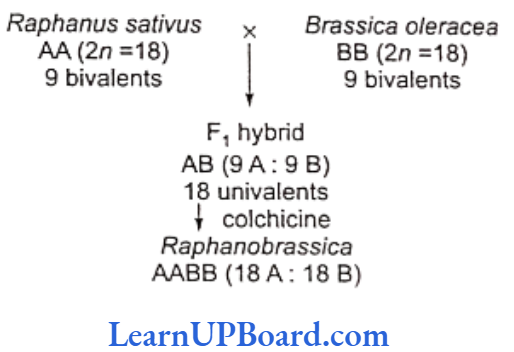
Another example is a man-made cereal, Triticale, produced by (a) crossing Triticum durum (2n = 28) with Secale cereale (2n = 14) and then treating the F, hybrid with colchicine to obtain hexaploid triticale and (b) crossing Triticum aestivum (2n = 42) with Secale cereale (2n = 14) and then treating the F, hybrid with colchicine to produce octaploid triticale.
Mutagens
Mutations can be artificially produced by certain agents called mutagens or mutagenic agents. Following are two major types of mutagens:
- Physical mutagens
- Chemical mutagens
Physical Mutagens
- Radiations are the most important physical mutagens.
- H.J. Muller, who used X rays for the first time to increase the rate of mutation in Drosophila, opened an entirely new field in inducing mutations.
- So, Muller is considered as the father of actinobiology.
- The main source of spontaneous mutations is natural radiations coming from the cosmic rays of the sun.
- The spectrum of wavelengths that are shorter (i.e., of higher energy) than the visible light can be subdivided into the following two groups:
- Ionizing radiations
- Non-ionizing radiations
- Physical mutations occur in small amounts in the environment and are known as background radiations.
Following are the biological effects of radiations:
- Effects of ionizing radiations: These radiations include X rays, y rays, a rays, and Brays. Ionizing radiations cause breaks in the chromosome. These cells then show abnor- mal cell divisions. If these include gametes, they may be abnormal and even die prema- turely. Different types of cancers may result due to radiations. The frequency of induced mutations is directly proportional to the doses of radiations.
- Effects of non-ionizing radiations: These radiations have longer wavelengths but carry lower energy. This energy is insufficient to induce ionization. Therefore, non-ionizing radiations such as UV light do not penetrate beyond the human skin. Thymine (pyrimidine) dimer formation is a major mutagenic effect of UV rays that disturbs DNA double helix and, thus, DNA replication.
Chemical Mutagens
- A large number of chemical mutagens are now known. These are more injurious than radiations. The first chemical mutagen used was mustard gas by C. Auer- bach et. al. during World War II.
- Chemical mutagens are placed into two groups:
- Those which are mutagenic to both replicating and non-replicating DNA such as nitrous acid and
- Those which are mutagenic only to replicating DNA such as acridine dyes and base analogs.
- Following are the effects of some chemical mutagens:
- Nitrous acid: It is mutagenic to both replicating and non-replicating DNA. It acts directly by oxidative deamination on A, G, and C bases which contain amino groups. A is deaminated to hypoxanthine which is complementary to cytosine. G is converted to xanthine which pairs with C. Cytosine is converted to U which pairs with A.
- Acridines: Acridines and proflavins are very powerful mutagens. These can intercalate between DNA bases and interfere with DNA replication, producing insertion or deletion or both of single bases, respectively. This induces frame- shift mutation or gibberish mutation, eg, thalassemia.
- Base analogs: These have structures similar to the normal bases and are incorporated into DNA only during DNA replication. Base analogs cause mis-pairing and eventually give rise to mutations. Base analogs may be either natural or artificial. Natural base analogs include 5-methyl cytosine, 5-hydroxymethyl cytosine, 6-methyl purine, etc. The most commonly used artificial base ana- logs are 5-bromouracil and 2-aminopurine. 5-Bromouracil is a structural analog of thymine. It gets incorporated into the newly replicated DNA in place of thymine (T). 2-Aminopurine is an artificial base analog of adenine. It acts as a substitute of adenine (A) and can also pair with cytosine (C).
NEET Biology Notes For Principles Of Inheritance And Variation Cytoplasmic Inheritance
- Some self-replicating genes (DNA) are present in the cytoplasm (mitochondrial DNA and chloroplast DNA) also.
- These are called plasmagenes. All plasmagenes to- gether constitute plasmon (like genome).
- The inheritance of characters by plasmagenes is called extranuclear or extrachromosomal inheritance.
- The most important examples of extranuclear inheritance in eukaryotes are maternal inheritance and organelle inheritance.
Maternal Inheritance
- The amount of nuclear hereditary material contributed by the two sexes is almost equal but the cytoplasm in the egg is always much more than that in the sperm.
- So, in extranuclear inheritance, the contribution of fe- male parent is more.
- This is called maternal inheritance.
- The evidence of maternal inheritance is the coiling of shell in snails.
NEET Biology Notes For Principles Of Inheritance And Variation Genetic Disorders
Pedigree Analysis
- A record of inheritance of certain genetic traits for two or more generations presented in the form of a diagram or family tree is called pedigree.
- Parents are shown by horizontal line while their off- springs are connected to it by a vertical line.
- The offsprings are also shown in the form of a horizontal line below the parents and numbered with Arabic numerals.
- Pedigree analysis is the study of pedigree for the transmission of a particular trait and finding the possibility of absence or presence of that trait in homozygous or heterozygous state in a particular individual.
- It is useful for genetic counselors to advise intending couples about the possibility of having children with genetic defects such as hemophilia, colorblindness, alkaptonuria, phenylketonuria, thalassemia, sickle-cell anemia (recessive traits), brachydactyly, myotonic dystrophy, and polydactyly (dominant traits).
- Pedigree analysis indicates that Mendel’s principles are also applicable to human genetics with some modifications found out later such as quantitative inheritance, sex-linked characters, and other linkages.
Symbols Used in Pedigree Analysis
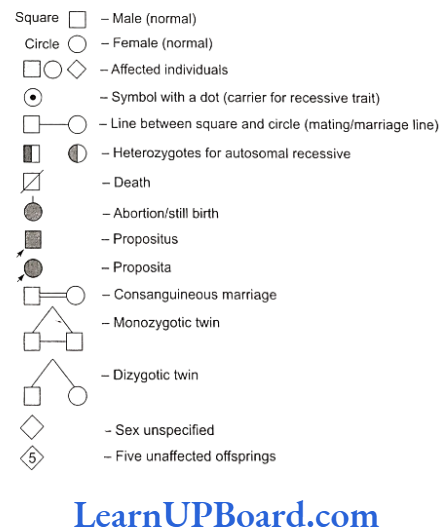
- Proband is the person from which case history starts. If it is male, it is called propositus; if it is female, it is called proposita.
NEET Biology Notes For Principles Of Inheritance And Variation Mendalian Disorders
Sickle-Cell Anemia
- It is an autosomal recessive disorder. In this disorder, the RBCs become sickle shaped under low O2 concentration.
- The affected persons die young.
- Other heterozygous individuals for this trait have normal phenotype and live long.
- The disease is due to the base substitution of the sixth codon in gene coding for the ẞ chain of hemoglobin.
- The middle base of a DNA triplet coding for the amino acid glutamic acid is mutated so that the triplet now codes for valine instead.
- The mutant hemoglobin molecule undergoes polym- erization under low O2 tension causing a change in the shape of RBC from biconcave disc to elongated sickle-like structure .
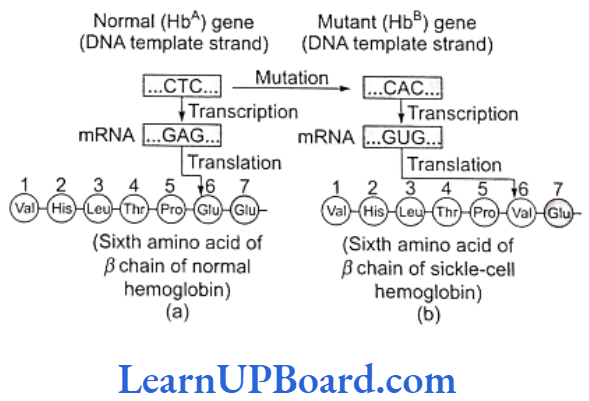
Thalassemia
Thalassemia is a recessive autosomal disease caused due to the reduced synthesis of a or ẞ polypeptide of hemoglobin. B-thalassemia is a major problem; individuals suffering from major thalassemia often die before ten years of age.
Phenylketonuria
Phenylketonuria is a recessive autosomal disorder (chromosome 12) related to phenylalanine metabolism. This disorder is due to the absence of a liver enzyme called phenylalanine hydroxylase. Due to the lack of this enzyme, phenylalanine follows another pathway and gets converted into phenylpyruvic acid.
This phenyl pyruvic acid upon accumulation in joints causes arthritis; if it hits the brain, it causes mental retardation known as phenyl pyruvic idiocy. Phenylalanine are also excreted through urine because of poor absorption by kidney.
Cystic Fibrosis
Cystic fibrosis is an autosomal recessive disorder common among Caucasian Northern Europeans. Persons suffering from this disease have extremely salty sweat. It is due to decreased Na and CI reabsorption in the ducts.
The disease is due to a gene present on chromosome 7. Due to a defective glycoprotein, thick mucus develops in pancreas and lungs and the formation of fibrous cyst occurs in pancreas.
Huntington’s Chorea
Huntington’s chorea is an autosomal dominant disorder. The gene responsible for this disorder is present on chromosome 4. The disease is characterized by the gradual degradation of brain tissue in the middle age and consequent shrinkage of brain.
Alzheimer’s Disease
Alzheimer’s disease is an autosomal recessive disease that results in mental deterioration (loss of memory, confusion, and anxiety) and, ultimately, the loss of functional capacities. The disease is due to the deposits of ẞ-amyloid, a short protein in brain which results in the degradation of neurons. It involves two defective alleles located on chromosomes 19 and 21. This disease is common in Down’s syndrome.
Myotonic dystrophy is due to a dominant autosomal mutant gene located on the long arm of chromosome 19. Mild myotonia (atrophy and weakness of the musculature of the face and extremities) is most common.
Other Mendelian Disorders
- Alkaptonuria (Garrod, 1908): Due to deficiency of oxidase enzyme
- Albinism (chromosome 11): Absence of tyrosinase
- Tay-Sach’s disease (chromosome 15): Absence of hexosaminidase B
- Gaucher’s disease (chromosomes 1): Due to the inhibition of glucocerebrosidase enzyme action which leads to accumulation of cerebroside
Other Abnormalities due to Autosomal Dominant Gene Mutation
- Polydactyly: Presence of extra fingers and toes
- Brachydactyly: Abnormal short fingers and toes
Abnormalities due to Sex-Linked (X-Linked) Recessive Gene Mutation
- Hemophilia A: Due to lack of antihemophilic globulin
Hemophilia B: Due to lack of plasma thromboplastin - Red-green colorblindness: Daltonism
Protanopia: Red colorblindness
Tritanopia: Blue colorblindness
Deuteranopia: Green colorblindness - Muscular dystrophy: Due to non-synthesis of protein dystrophin; deterioration of muscles at an early stage
- Lesch Nyhan syndrome: Deterioration of nervous system due to HGPRT (hypoxanthin guanine phosphoribosyl transferase) deficiency
NEET Biology Notes For Principles Of Inheritance And Variation Chromosomal Disorders
- Autosomal abnormalities (due to mutation in body chromosome)
- Down’s syndrome: It occurs due to the trisomy of the 21st chromosome. The affected individual is short-statured with small round head, furrowed tongue, and partially open mouth. The palm is broad with characteristic palm crease and mental retardation. Physical and psychomotor develop- ment is retarded.
- Edward’s syndrome: It occurs due to the trisomy of the 18th chromosome.
- Patau’s syndrome: It occurs due to the trisomy of the 13th chromosome.
- Cri du chat syndrome: It occurs due to deletion in the short arm of the fifth chromosome.
- Allosomal or sex chromosomal disorder
- Klinefelter’s syndrome: It occurs due to the trisomy of the X-chromosome in male, resulting in a karyotype of 47 (44 + XXY). Individuals have long legs, sparse body hair, small prostrate gland, small testes, reduced mental intelligence, and enlarged breasts (gynaecomastia). Such individuals are sterile.
- Turner’s syndrome: It is caused due to the absence of one of the X-chromosomes in females, i.e., 45 with chromosome complement 44 + XO. Such females are sterile with undeveloped breasts, short stature, reduced ovaries, and absence of menstrual cycle.
- Super-female: AA+ XXX, AA + XXXX
- Jacob’s syndrome or super-male: AA + XYY, also called criminal syndrome
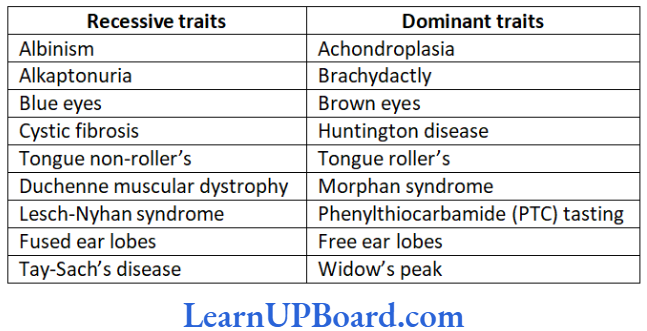
NEET Biology Notes For Principles Of Inheritance And Variation Population Genetics
Hardy Weinberg’s equation is applied to know the distribution of traits and the frequency of autosomal dominant recessive gene distribution in the entire population.
p = Dominant gene/allele
q= Recessive gene/allele
p+q=1
(p+q)2= p2+q2+2pq=1
2/3(p2+2pq) = Frequency of dominant trait
1/3(92) = Frequency of recessive trait
NEET Biology Notes For Principles Of Inheritance And Variation Some Important Definitions
- The subject that deals with the inheritance as well as the variation of characters from parents to offspring is called genetics.
- Inheritance is the process by which characters are passed on from parent to progeny.
- Variation is the degree by which progeny differ from their parents.
- A true breeding line is one that, having undergone con- tinuous selfing, shows the stable trait inheritance and expression for several generations.
- Genes that code for a pair of contrasting traits are known as alleles.
- A cross between F, hybrid (Tt) and its homozygous recessive parent (tt) is called a test cross.
- If F, phenotype does not resemble either of the two parents and is in between the two, it is called incom- plete dominance.
- The presence of more than two alleles for a gene is known as multiple allelism.
- If F, phenotype resembles both the parents, it is called co-dominance.
- If more than one phenotype is influenced by the same gene, it is called pleiotropy.
- If two genes present on different loci produce the same effect when present alone but interact to form a new trait when present together, they are called comple- mentary genes.
- A gene that masks the action of another gene (non- allelic) is termed as an epistatic gene. The process is called epistasis.
- Polygenic inheritance is controlled by two or more genes in which the dominant alleles have cumulative effect, with each dominant allele expressing a part of functional phenotype and full trait is shown when all dominant alleles are present.
- The tendency of some genes to inherit together is called linkage.
- Sex-limited traits are autosomal and found in both sexes but are expressed in one sex only.
- Sex-influenced traits are autosomal and appear more frequently in one sex than in the other.
- Mutation is sudden, inheritable, discontinuous varia- tion due to change in chromosomes and genes.
- If mutation arises due to change in a single base pair of DNA, it is known as point mutation.
- The failure of segregation of chromatids during cell division cycle results in the gain or loss of a chromosome(s), called aneuploidy.
- The failure of cytokinesis after the telophase stage of cell division results in an increase in the whole set of chromosomes in an organism. This phenomenon is known as polyploidy.
- A record of inheritance of certain genetic traits for two or more generations presented in the form of a diagram or family tree is called pedigree.
NEET Biology Notes For Principles Of Inheritance And Variation Formula Chart
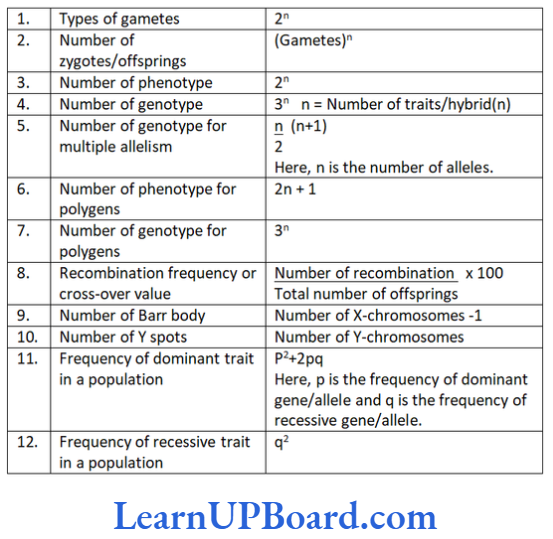
NEET Biology Notes For Principles Of Inheritance And Variation Summary
- Genetics is a branch of biology which deals with the principles of inheritance and variation.
- Mendelian inheritance (Mendelism)
- Mendel proposed that something was being stably passed down, unchanged, from parent to offspring through the gametes, over successive generations. He called these things as “factors.”
- Dominant characters are expressed when factors are in heterozygous condition (law of dominance).
- The characters never blend in heterozygous condition.
- Recessive characters are only expressed in homozygous condition.
- A recessive trait that was not expressed in heterozygous condition may express again when it becomes homozygous. Hence, characters segregate during the formation of gametes (law of segregation).
- Mendel also studied the inheritance of two characters together and he found that the factors independently assort and combine in all permutations and combinations.
- The factors on chromosomes regulating the characters are called the genotype and the physical expression of the characters is called phenotype.
- Walter Sutton and Theodore Boveri noted that the behavior of chromosomes was parallel to the behavior of genes and used chromosome movement to explain Mendel’s laws.
- Mendel’s law of independent assortment is not true for genes that are located on the same chromosome (i.e., linked genes).
- Closely located genes assorted together, and distantly located genes, due to recombination, assorted independently.
- The frequency of recombination between gene pairs on the same chromosome is a measure of the distance between the genes.
- Mutation is defined as the change in the genetic material. A point mutation is a change of a single base pair in DNA. Some mutations involve changes in the whole set of chromosomes (polyploidy) or change in a subset of chromosome number (aneuploidy).
- Sickle cell anemia is caused due to change of one base in the gene coding for B-chain of hemoglobin.
- Inheritable mutations can be studied by generating a pedigree of a family.
- Down’s syndrome is due to the trisomy of chromo- some 21. In Turner’s syndrome, one X-chromosome is missing and the sex chromosome is XO.
- In Klinefelter’s syndrome, the condition is XXY.
NEET Biology Notes For Principles Of Inheritance And Variation Assertion-Reasoning Questions
In the following questions, a statement of Assertion (A) is followed by a statement of Reason (R).
- If both Assertion and Reason are true and the reason is the correct explanation of the assertion, then mark (1).
- If both Assertion and Reason are true but the reason is not the correct explanation of the assertion, then mark (2).
- If Assertion is true but Reason is false, then mark (3).
- If both Assertion and Reason are false, then mark (4).
Question 1. Assertion: Mendel gave postulates such as “principles of segregation” and “principles of independent assortment” after studying seven pairs of contrasting traits in garden pea.
Reason: He was lucky in selecting seven characters in pea that were located on seven different chromosomes.
Answer. 3. If Assertion is true but Reason is false, then mark (3).
Question 2. Assertion: Test cross is the tool for knowing linkage be- tween genes.
Reason: Monohybrid test cross gives two phenotypes and two genotypes.
Answer. 2. If both Assertion and Reason are true but the reason is not the correct explanation of the assertion, then mark (2).
Question 3. Assertion: Marfan syndrome is caused by recessive mu- tant pleiotropic gene.
Reason: Gene mutation leads to more synthesis of fibril- lin proteins.
Answer. 4. If both Assertion and Reason are false, them mark (4).
Question 4. Assertion: In snapdragon, F, plants do not have red or white flowers.
Reason: It is intermediate inheritance with neither of the two alleles of a gene being dominant over each other.
Answer. 1. If both Assertion and Reason are true and the reason is the correct explanation of the assertion, then mark (1).
Question 5. Assertion: en block inheritance of all genes located on the same chromosome may occur in some organisms.
Reason: Dihybrid test cross will have only two pheno- types.
Answer. 4. If both Assertion and Reason are false, them mark (4).
Question 6. Assertion: Morgan’s cross III was conducted in Drosophila to locate genes on chromosome for white eye color.
Reason: The cross was done between red-eyed hybrid female and white-eyed male.
Answer. 3. If Assertion is true but Reason is false, then mark (3).
Question 7. Assertion: Antlers in male deer are sex influenced traits.
Reason: These are controlled by autosomal genes which are influenced by the sex of bearer.
Answer. 4. If both Assertion and Reason are false, them mark (4).
Question 8. Assertion: One drumstick per nucleus is present in the neutrophil of normal female.
Reason: It is absent in the neutrophil of male.
Answer. 2. If both Assertion and Reason are true but the reason is not the correct explanation of the assertion, then mark (2).
Question 9. Assertion: Blood group phenotype is controlled by the presence or absence of antigens present on the surface coating of ABC.
Reason: These antigens are of three types and found in the oligosaccharides-rich head regions of a glycophorin.
Answer. 2. If both Assertion and Reason are true but the reason is not the correct explanation of the assertion, then mark (2).
Question 10. Assertion: XX-XY type sex determination is found in Coccinia indica.
Reason: Male plant is produced only when Y-chromosome is present irrespective of the number of X-chromosomes.
Answer. 1. If both Assertion and Reason are true and the reason is the correct explanation of the assertion, then mark (1).
Question 11. Assertion: Drosophila melanogaster is widely used in genetic research.
Reason: Drosophila melanogaster is a readily available insect.
Answer. 2. If both Assertion and Reason are true but the reason is not the correct explanation of the assertion, then mark (2).
Question 12. Assertion: In humans, the gamete contributed by the male determines whether the child produced will be male or female.
Reason: Sex in humans is a polygenic trait depending upon the cumulative effect of some genes on X-chromosome and some on Y-chromosome.
Answer. 3. If Assertion is true but Reason is false, then mark (3).
Question 13. Assertion: A father may be a hemophilic only if his mother is carrier.
Reason: A father cannot pass on a sex-linked gene to his son.
Answer. 1. If both Assertion and Reason are true and the reason is the correct explanation of the assertion, then mark (1).
Question 14. Assertion: An organism with lethal mutation may not even develop beyond the zygote stage.
Reason: All types of gene mutations are lethal.
Answer. 3. If Assertion is true but Reason is false, then mark (3).
Question 15. Assertion: Cancer cells are virtually immortal until the body in which they reside dies.
Reason: Cancer is caused by damage to genes regulating the cell division cycle.
Answer. 2. If both Assertion and Reason are true but the reason is not the correct explanation of the assertion, then mark (2).
